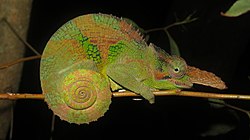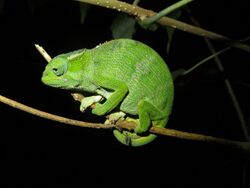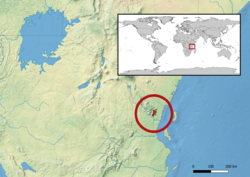Biology:Kinyongia vosseleri
| Kinyongia vosseleri | |
|---|---|

| |

| |
| Male above, female below | |
| Scientific classification | |
| Domain: | Eukaryota |
| Kingdom: | Animalia |
| Phylum: | Chordata |
| Class: | Reptilia |
| Order: | Squamata |
| Suborder: | Iguania |
| Family: | Chamaeleonidae |
| Genus: | Kinyongia |
| Species: | K. vosseleri
|
| Binomial name | |
| Kinyongia vosseleri (Nieden, 1913)
| |

| |
| Synonyms[2] | |
| |
Kinyongia vosseleri, also known commonly as the Usambara two-horned chameleon and Vosseler's blade-horned chameleon, is an endangered species of lizard in the family Chamaeleonidae. The species is endemic to Tanzania.
Taxonomy and etymology
K. vosseleri was already described as a species in 1913 by Fritz Nieden, with the specific name, vosseleri being in honor of German zoologist Julius Vosseler (de).[3] Subsequently, it was generally considered a synonym of K. fischeri. It was only in 2008 that it was verified that the two are separate species with fully separated distributions.[1][4]
Geographic range and habitat
K. vosseleri is only found in forests in the East Usambara Mountains of Tanzania, at an altitude of up to c. 1,500 m (4,900 ft).[1] Its range overlaps with the closely related K. matschiei, whereas K. multituberculata is found in the West Usambara Mountains.[4]
Appearance
K. vosseleri is a medium-large species in the genus Kinyongia at up to 29.5 cm (11.6 in) in total length, with the tail making up more than half of that. Females do not grow as large as males. Adult males have a large pair of converging horns on the nose. Uniquely in the "two-horned Usambara group", adult females of K. vosseleri entirely lack horns (in K. matschiei and K. multituberculata, adult females have small horns; however, juveniles are essentially hornless). The only close relatives where the adult female lacks horns are K. boehmei and K. tavetana, but they are not from the Usambaras.[4]
See also
- Trioceros deremensis, the Usambara three-horned chameleon
References
- ↑ 1.0 1.1 1.2 Tolley, K.; Menegon, M. (2014). "Kinyongia vosseleri". IUCN Red List of Threatened Species 2014: e.T172525A1344219. doi:10.2305/IUCN.UK.2014-3.RLTS.T172525A1344219.en. https://www.iucnredlist.org/species/172525/1344219. Retrieved 20 November 2021.
- ↑ Species Kinyongia vosseleri at The Reptile Database www.reptile-database.org.
- ↑ Beolens B, Watkins M, Grayson M (2011). The Eponym Dictionary of Reptiles. Baltimore: Johns Hopkins University Press. xiii + 296 pp. ISBN:978-1-4214-0135-5. (Kinyongia vosseleri, p. 277).
- ↑ 4.0 4.1 4.2 Mariaux J, Lutzmann N, Stipala J (2008). "The two-horned chamaeleons of East Africa". Zoological Journal of the Linnean Society 152: 367-391.
Further reading
- Nieden F (1913). "Chamaeleon fischeri Rchw. und seine Unterarten ". Sitzungsberichte der Gesellschaft Naturforschender Freunde zu Berlin 1913 (4): 231–249 + Plates XIV–XVI. (Chamaeleon fischeri vosseleri, new subspecies, pp. 247–248 + Plate XV, figure 5, male; Plate XVI, figure 9, female). (in German).
- Spawls, Stephen; Howell. Kim; Hinkel, Harald; Menegon, Michele (2018). Field Guide to East African Reptiles, Second Edition. London: Bloomsbury Natural History. 624 pp. ISBN:978-1472935618. (Kinyongia vosseleri, p. 278).
- Tilbury, Colin (2010). Chameleons of Africa, an Atlas, including the chameleons of Europe, the Middle East and Asia. Frankfurt am Main: Edition Chimaira / Serpents Tale. 831 pp. ISBN:978-3899734515. (Kinyongia vosseleri, p. 418).
Wikidata ☰ Q3197245 entry
 |


